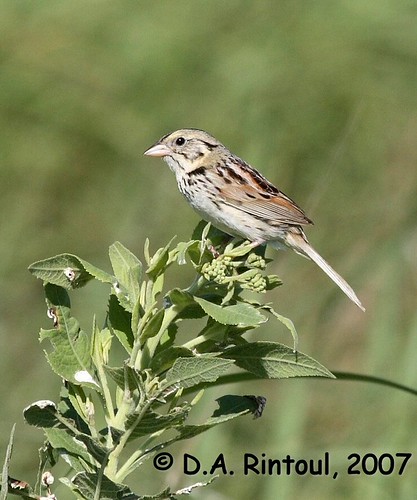tags: Henslow's Sparrow, Ammodramus henslowii, birds, mystery bird, bird ID quiz
[Mystery bird] Henslow's Sparrow, Ammodramus henslowii, photographed in Manhattan, Kansas. [I will identify this bird for you tomorrow]
Please name at least one field mark that supports your identification.
Rick Wright, Managing Director of WINGS Birding Tours Worldwide, writes:
This is a small, medium-tailed, fat-bodied, big-headed, huge-billed sparrow. And that's probably enough: many birders would be able to identify this bird just from that description without even looking at this terrifically beautiful portrait of a Henslow's Sparrow.
For confirmation, we can look at the extensive rust in the wings, the olive wash to the nape, the neat breastband, and the well-defined lateral throat and moustachial stripes (the "double whisker"). Baird's Sparrow, a surprisingly similar species, lacks the rufous in the tertials and shows clear streaking on the brownish nape.
Henslow's Sparrow has long been a bird to worry about, in steep decline along with its specialized habitat of extensive grassy fields with tall forbs for singing. Its salvation in the east has been the recuperation of old strip mines, while the species gives every sign of recovery in tallgrass prairies remnants in the Midwest. Careful grassland management can save this bird, and the Dickcissels, Grasshopper Sparrows, and Regal Fritillaries it shares its weedy home with.
- Log in to post comments


Not having ever seen one, I will venture a guess at Baird's Sparrow. Field marks include the flat-topped head, overall buff colored face, the facial pattern, and the streaks across the chest. There's a hint of the central crown stripe there, but it's tough to see.
My guess is a henslow's sparrow base on the streaks on the back, olive color and long bill.
Grasshopper Sparrow!
Mr. Rintoul has a nice photo of an adult Baird's Sparrow. It's a Baird's for the field marks noted by Patrick, plus the prominent black neck spot.
I think it's Henslow's Sparrow, based on partially broken (at the back) white eye ring, fine streaked chest in narrow band, plus JPS's comments. Also, the location suggests Henslow's rather than Baird's.
I too think Henslow's. The chest is streakier, the face stripier, and you can just see the light center in the stripe on the top of the head.
Fascinating discussion. Of "small, medium-tailed, fat-bodied, big-headed, huge-billed sparrow", which doesn't apply to Baird's?
It's striking how much this bird's face pattern, except the nape, resembles Sibley's picture of Baird's, with distinct differences from his picture of Henslow's, while the underparts are different from either. If they bred in the same place, I'd be wondering about a hybrid.
Apparently, for Baird's and Henslow's sparrows, nape color and pattern are reliable but face and side-of-neck pattern aren't. Where can one find out what marks are reliable?
Jerry, to be honest, it never occurred to me that anyone could mistake the bird for Baird's in a view like this--they are remarkably similar, as my brief analysis notes, but I've never seen a Baird's with a clean greenish nape, a solid dark crown (with just the "notch" above the bill suggesting a median stripe), a rusty wing, gray auriculars, or a bill that outsized. The back pattern differs, too, with much more white on a Baird's. No reason to invoke hybrid origin; this is a classic Henslow's to my eye.
Check Rising and Beadle (and not Beadle and Rising--much the weaker effort), Pyle, and BNA for some good discussions of separating Baird's from Henslow's.
Thanks, Rick. If I may be equally honest, I'm not surprised at all that people took this for Baird's. It has much lighter underparts than the illustration of Henslow's in Sibley, even lighter than his Baird's--apparently this is a problem with Sibley, as Henslow photos on the Web match this bird. The face of this bird is distinctly lighter than other Henslow photos, and I can see why that would make Baird's someone's first thought. And then this bird has that neck spot that Sibley says is distinctive. Apparently it's not so distinctive--this Henslow's has something very similar. If you look at Sibley's, you won't be surprised any more. (And I for one have never seen either of these sparrows.)
As for the bill size, I can't see the difference. So I found this photo of a Baird's and got out my ruler. I think the Henslow's bill is between 5% and 10% longer and deeper compared to the size of the head, maybe 7% or 8%. I'm impressed that you can see that! But if you'll forgive a pedagogical suggestion, I don't think it's helpful to call the Henslow's bill "huge" and "outsize". "Outsize bill" suggests a Long-billed Curlew to me, and "huge bill" suggests a pelican. When you compared Henslow's to Baird's in your kind response, I'd have understood you better if you'd done so on the basis that there's a small difference that some readers can see and others can learn to look for.
One moral for me is to look at pictures on the Web in addition to field guides.
Thank you very much for the references! I may consult the budget.